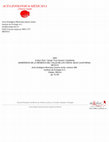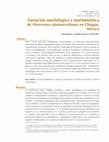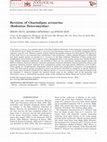Papers by Evelyn Jesus Rios
Southwest Naturalist, 2003
... 1999. Familia Muridae. In: Alvarez-Castañeda, ST, and JL Patton, editors. Mamíferos del no-ro... more ... 1999. Familia Muridae. In: Alvarez-Castañeda, ST, and JL Patton, editors. Mamíferos del no-roeste de México. Centro de Investigaciones Biológicas del Noroeste, SC. Elliot, DG 1903. Description of twenty-seven apparently new species and subspecies of mammals. ...
Journal of Mammalogy, Aug 1, 2007
ABSTRACT

Http Dx Doi Org 10 1644 09 Mamm a 135, Apr 16, 2010
ABSTRACT The systematics and phylogeography of the San Diego pocket mouse (Chaetodipus fallax), a... more ABSTRACT The systematics and phylogeography of the San Diego pocket mouse (Chaetodipus fallax), a species restricted to the Baja California Peninsula and adjacent southwestern California, were assessed using sequences of the mitochondrial cytochrome-b gene (Cytb). Genetic relationships were evaluated among the 6 recognized subspecies of C. fallax (including the island population, C.f. anthonyi) in 3 geographic regions from individuals representing 22 populations. Analysis of molecular variance and multiple phylogenetic analyses indicated 3 main clades: northern populations in the southwestern Mojave Desert and Los Angeles Basin north of the Salton Trough; central populations from south of the Salton Trough and throughout the state of Baja California; and southern populations from west of the Vizcaino Desert in Baja California Sur and adjacent Isla Cedros. These clades do not correspond to the currently recognized subspecies, and each could be considered a distinct subspecies pending analysis of nuclear DNA or characters (e.g., morphology) encoded by nuclear DNA.

El Valle de los Cirios es el área natural protegida más extensa de México. En la península de Baj... more El Valle de los Cirios es el área natural protegida más extensa de México. En la península de Baja California existe el mayor número de subespecies de mamíferos endémicos por área de distribución en todo el país, sin embargo, los trabajos mastofaunísticos realizados en la región son escasos. Por ende, el Valle de los Cirios no cuenta con algún estudio de este tipo que permita conocer lo que dicha reserva protege. Se realizaron cuatro colectas de mamíferos en el Valle de los Cirios durante el año de 1998 para conocer las especies y subespecies presentes, su distribución y formar una colección de referencia. Se colectó en un total de 40 localidades distribuidas por el área, cubriendo los diferentes tipos de vegetación presentes. Como resultado, se identificaron cinco órdenes, 11 familias, 21 géneros, 27 especies y 38 subespecies, lo que corresponde al 5.9% de las especies de mamíferos reportadas para México. Se amplió la distribución de Perognathus longimembris y de Reithrodontomys megalotis. Se formó una colección de referencia con un total de 919 ejemplares. Una especie registrada en el Valle de los Cirios aparece en la Norma Oficial Mexicana (2000) como amenazada y siete subespecies son endémicas para la reserva. El Valle de los Cirios es un área que se encuentra en excelentes condiciones de integridad lo que la hace idónea para la realización de diferentes estudios. Palabras clave: Mamíferos, Reserva Valle de los Cirios,
n capítulos anteriores ya se ha señalado la importancia de las colecciones mastozoológicas. En el... more n capítulos anteriores ya se ha señalado la importancia de las colecciones mastozoológicas. En ellas está representada la mastofauna regional y nacional, constituyen una extraordinaria fuente de información biológica, ecológica y taxonómica de las especies, a lo que se suma otro valioso aspecto para la investigación: también fungen como un acervo de biodiversidad genética.
Ucv Scientia, Mar 19, 2015
Western North American Naturalist, 2014

Therya, 2011
Nine cranial and four morphologic measurements of Heteromys desmarestianus specimens of different... more Nine cranial and four morphologic measurements of Heteromys desmarestianus specimens of different geographic regions of Chiapas were examined, with the aim of extending the taxonomic and systematic knowledge of the species and to estimate its levels of morphometric and morphologic variation throughout its distribution in the state of Chiapas. The geographic distribution of the subspecies of H. desmarestianus in Chiapas is not uniform and it occurs in different subprovinces in diverse altitudes and types of vegetation. There are variations in cranial morphometry and morphology (pelage coloration) among the subspecies of H. desmarestianus. Particularly, H. d. goldmani presented larger differentiation with respect to H. d. desmarestianus and H. d. griseus; it is for this reason that we reconsider its change at specific level. Nevertheless, H. d. desmarestianus and H. d. griseus do not present significant differences in cranial and pelage color characteristics, and H. d. griseus can be considered in synonymy with H. d. desmarestianus.

Zoological Journal of the Linnean Society, 2011
Chaetodipus arenarius is an endemic species of the Baja California Peninsula. It has undergone ta... more Chaetodipus arenarius is an endemic species of the Baja California Peninsula. It has undergone taxonomic changes in the last few years. Today, two species, C. arenarius and Chaetodipus dalquesti, are formally recognized with an unknown range for each. However, genetic analysis showed the possible presence of a third species. The objectives of this study were to use molecular data (cytochrome b and cytochrome c oxidase subunit III genes) to determine how many genetic groups are present in C. arenarius in the Baja California Peninsula; if these groups have morphological characteristics that could be used to distinguish them; if the genetic groups have limited distributions; identify taxonomic implications; and establish if there are any associations amongst genetic groups and different habitats. Bayesian inference, maximum parsimony, maximum likelihood, distance optimality criteria, and minimum spanning network indicated three monophyletic groups with high genetic differences (5.54-13.59%). These groups are morphologically diagnosable based on pelage and morphometric characters and geographical range. The three genetic groups correspond to three taxa previously described as subspecies or species. Based on our results, these should be considered to be different species: C. arenarius occupies the most extreme habitats with hot summers; C. dalquesti occupies the moistest coastal areas in the southern part of the peninsula, and Chaetodipus siccus is restricted by mountain ranges to the isolated Los Planes Basin and Cerralvo Island.
Western North American Naturalist, 2013
The Southwestern Naturalist, 2003
... 1999. Familia Muridae. In: Alvarez-Castañeda, ST, and JL Patton, editors. Mamíferos del no-ro... more ... 1999. Familia Muridae. In: Alvarez-Castañeda, ST, and JL Patton, editors. Mamíferos del no-roeste de México. Centro de Investigaciones Biológicas del Noroeste, SC. Elliot, DG 1903. Description of twenty-seven apparently new species and subspecies of mammals. ...
The Southwestern Naturalist, 2001
Mammalian Species, 2011
... Peromyscus guardia (Rodentia: Cricetidae). Evelyn Rios and Sergio Ticul Álvarez-Castañeda ...... more ... Peromyscus guardia (Rodentia: Cricetidae). Evelyn Rios and Sergio Ticul Álvarez-Castañeda ... 2). Individuals of P. guardia differ from those of P. interparietalis (San Lorenzo deermouse) by the nearly complete absence of mesostyles and entostyles on M1 (Lawlor 1971). ...










Uploads
Papers by Evelyn Jesus Rios